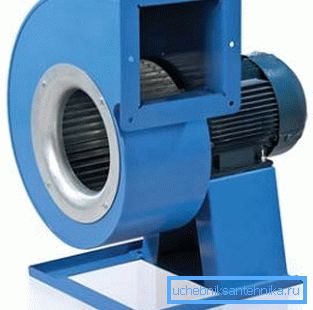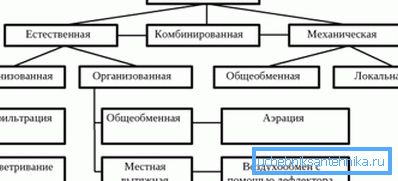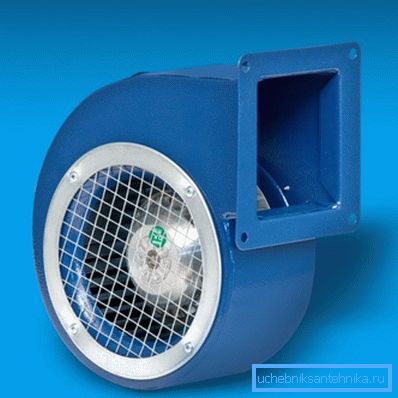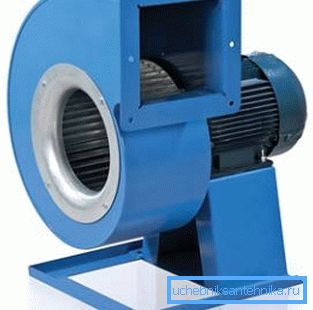What is a vent snail: features of the device
The so-called snail for ventilation can not always mean the same kind of coercive ventilation device - the main common features are the shape of the unit, but not the principle of operation and direction of the air flow.
Injection devices of this type can:
- radically different on the principle of the device blades;
- and can also be of the inflow or exhaust type, that is, direct the flow in the opposite direction.

They are usually used for solid fuel boilers of large size, production shops and public buildings, but about all this below, and in addition - the video in this article.
Mechanical ventilation
Note. Injection / suction units with an electric motor, which are called a cochlea, are not suitable for any kind of ventilation, as they can direct the air flow only in one direction.
Types of ventilation

- As you can see in the upper image, the word ventilation may mean completely different ways of air exchange and you may not even have heard about some of them, but we will briefly consider only the most basic ones.
- Firstly, there is a well-known exhaust method when warm or polluted air is removed from the room.
- Secondly, there is a supply option, and most often it is the addition of fresh cool air.
- Thirdly, it is a combination, that is, a supply and exhaust option.
- The above systems can function in a natural way, but they can also work forcibly, using axial (axial), radial (centrifugal), diametral (tangential) and diagonal fans. In addition, the hood and air flow can be carried out either in general or in local mode. That is, the duct is supplied to a specific destination and performs the function of blowing or exhaust.
Examples
Note. Below we consider several types of snails, which are used for the main types of ventilation.

BDRS 120-60 (Turkey) is a radial type exhaust snail with a weight of 2.1 kg, a frequency of 2325 rpm, a voltage of 220 / 230V / 50Hz and a maximum power consumption of 90W. At the same time, BDRS 120-60 is able to pump 380m at maximum.3/ min of air with a temperature range from -15? C to +40? C, has a safety class IP54.
BDRS can have several sizes, the external rotary engine is made of galvanized steel and is protected from the side with a chrome grille, which prevents the ingress of third-party elements on the impeller.

The heat-resistant intake-exhaust radial fan Dundar CM 16.2H is usually used to pump hot air out of solid fuel boilers, although the instruction also allows it to be used for premises of various purposes. The air flow during transportation can have a temperature from -30? C to +120? C, and the snail itself can be turned to 0? (horizontal position), 90 ?, 180? and 270? (engine on the right side).
The CM 16.2H model has an engine speed of 2750 rpm, a voltage of 220 / 230V / 50Hz and a maximum power consumption of 460W. The unit weighing 7.9 kg is able to pump a maximum volume of 1765m3/ min. air, pressure level 780Pa, has a degree of protection IP54.

Various modifications of VENTS VShCHUN can be used for the needs of supply and exhaust ventilation and air conditioning in premises of various purposes and have an air transportation capacity of up to 19000m3/hour.
Such a centrifugal volute has a spiral-rotary body and impeller, which is mounted on the axis of a three-phase asynchronous motor. Housing VSHCHUN made of steel, which is later coated with polymers
Any modification implies the ability to rotate the case to the right or left. This allows you to join the existing air ducts at any angle, but the step between the fixed position is 45 ?.
Also on different models, either two-stroke or four-stroke asynchronous engines with external rotor can be used, and its impeller in the form of forward-curved blades is made of galvanized steel. Rolling bearings increase the operating life of the unit, the turbines balanced at the factory significantly reduce noise, and the level of protection is IP54.

In addition, for VSBUN, you can adjust the speed with your own hands using an auto-transformer controller, which is very convenient for:
- changing seasons;
- working conditions;
- premises and so on.
In addition, several units of this type can be connected to the autotransformer device at once, but the main condition must be met without fail: their total power should not exceed the transformer rating.
| Parameter setting | VTSUN | |||||||
| 14074-0.25-2 | 14074-0,37-2 | 16074-0,55-2 | 16074-0,75-2 | 18074-0,56-4 | 18074-1,1-2 | 20093-0,55-4 | 20093-1,1-2 | |
| Voltage (V) at 50Hz | 400 | 400 | 400 | 400 | 400 | 400 | 400 | 400 |
| Power consumption (kW) | 0.25 | 0.37 | 0.55 | 0.75 | 0.55 | 1.1 | 0.55 | 1.1 |
| Current) A) | 0.8 | 0.9 | 1.6 | 1.8 | 1.6 | 2.6 | 1.6 | 2.6 |
| Maximum air flow (m3/hour) | 450 | 710 | 750 | 1540 | 1030 | 1950 | 1615 | 1900 |
| Rotational Speed (RPM) | 1350 | 2730 | 1360 | 2820 | 1360 | 2800 | 1360 | 2800 |
| Sound level at a distance of 3m (db) | 60 | 65 | 62 | 68 | 64 | 70 | 67 | 73 |
| Air temperature during transportation maximum t? C | 60 | 60 | 60 | 60 | 60 | 60 | 60 | 60 |
| Protection | IP54 | IP54 | IP54 | IP54 | IP54 | IP54 | IP54 | IP54 |
Technical characteristics VENTS VSHCHUN
Note. The above table shows the technical characteristics of only some modifications of VENTS VSHUN.
Conclusion
It is noteworthy that the ventilation snails can be used not only for large volumes (production workshops, public buildings, etc.), but also for household needs, in particular, for heating. Of course, the price of the units will differ significantly, but this is governed by increasing or decreasing power.